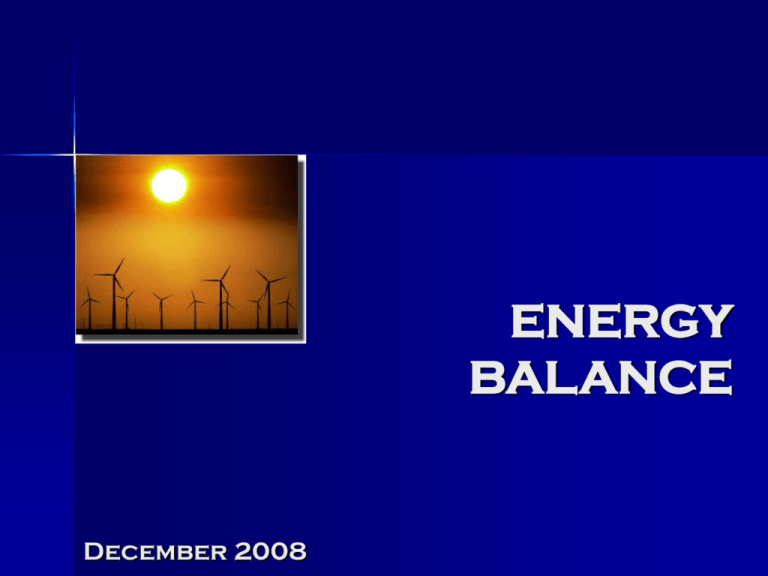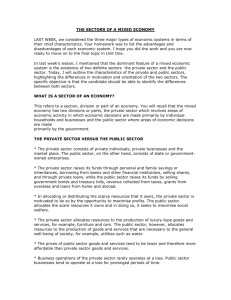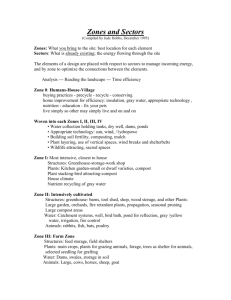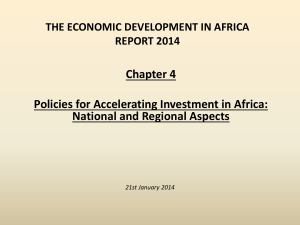energy balance - United Nations Statistics Division
advertisement

ENERGY BALANCE December 2008 Definition: The energy balance is an account in which shows the complete set of relations of equilibrium that accounts for streams Physical by which energy is produced, exchanged with the outside world, is transformed, consumed, and so on.; All this in a calculated common unit within a given country and for a specified period (usually one year). ADVANTAGES AND DISADVANTAGES: It is important to bear in mind both the advantages and limitations of the balance sheet. The balance sheet is a tool that facilitates global energy planning, but considered alongside other elements of the economic system. That is, taken in isolation the balance sheet gives a picture of the relationship of physical energy system in a particular historical period. Shows such as the energy is produced, exported or imported, is transformed and consumed by economic sectors. CONTINUED…… It lets calculate certain relationships of efficiency and make a diagnosis of the energy situation of a country, region or continent since. However, it is through their relationship with other socioeconomic variables that the balance becomes a planning tool. In this sense, the existence of the energy balance is a necessary condition for energy planning. CONTINUED…… The energy balances in terms of final energy (EBFE), has the limitation of not making an assessment of energy reserves and do not reach the stage of useful energy (EBUE). On the other hand, for developing countries, given the importance of the rural sector and the sources of "non-commercial" energy is essential to include in the balance sheet such consumption in order to meet the energy structure of the rural sector, its problems and implications on the national economy. FUNDAMENTAL OBJECTIVES OF THE ENERGY BALANCE: To assess the dynamics of the energy system in line with the economy of each country, identifying the major energy-economic relationships between the different sectors of the national economy. Serve as a tool for energy planning. Knowing in detail the structure of the national energy sector. Determine for each source of energy uses competitive and non-competitive to push wherever possible replacement processes. Create the appropriate bases leading systematization of information energy. to the improvement and Be used to allow the projection of energy and its prospects in the short and long term. OVERVIEW: The energy balance in terms of final energy (BEEF) of OLADE is presented in matrix form, and is composed of columns, which represent energy sources (primary and secondary), and by the rows that represent the activities, namely the origins and destinations or consumption of energy. The basic components of the balance sheet are: -ENERGY SOURCES Primary Energy Secondary Energy - TOTAL SUPPLY - PROCESSING CENTERS - FINAL CONSUMPTIO ENERGY BALANCE : COMPONENTS: The basic components of the balance sheet are: - ENERGY SOURCES -TOTAL SUPPLY - PROCESSING CENTERS Primary Energy Secondary Energy - FINAL CONSUMPTIO PRIMARY ENERGY .- The term primary energy to the various sources of energy as obtained in the wild, either in direct form as in the case of hydropower and solar, wood and other fuels plant, or after a process of extracting the oil, coal, geoenergy, and so on. SECONDARY ENERGY .- It's called secondary energy to the various energy products that come from different centers for processing and whose fate are the various sectors of consumption and / or other processing plants. TOTAL SUPPLY.- : It is the total net availability of energy to meet the energy needs of a country's economy. The total supply of energy is then, the amount of energy primary and secondary available to meet the energy needs of a country, both in the processes of transformation, and in the end. The "total supply" is calculated by the equation: Total bid = Production (+) Import (-) Export (+ -) Change in inventories (-) Not exploited CENTERS OF TRANSFORMATION : It refers to the energy that comes to be amended in special processor called processing centers, these centers produce chemical or physical changes of an energy source to another or others, looking this way better utilization of energy. CONTINUED…… The processing plants are considered: Refinery: Center where the oil is processed into products. In refineries basically crude oil is separated into its various components. Power Plants (Public and self producers): These processing plants are built according to the case, for hydroelectric power, thermal power conventional steam turbines, gas turbines and internal combustion engines, power plants and geothermoelectrics. Gas Treatment Center: In the treatment plants and associated natural gas is processed with the main purpose of recovering liquid hydrocarbons compounds, such as naphta and gasoline, pure hydrocarbons such as butane, propane, ethane or mixture of them and non energy, such as carbon, through a process of physical separation of the components of the gas. OWN CONSUMPTION : This is one of four possible routes for the total supply. The consumption of energy is the part of primary and secondary energy that the industry uses to function. LOSSES: Are those that occur during the activities undertaken since the energy is produced up to the final consumer. Among other things, include the loss of extraction, storage, transportation, transmission, distribution, etc.. Loss is different from untapped because while the latter could be exploited fully if conditions were given, the first can only be reduced through conservation. STATISTICAL ADJUSTMENT: This line serves mainly in some cases to replenish the differences produced by the conversion of different sources, from their original units of measure until the units are compatible for the development of the balances. The adjustment should be no higher than 5% of the total offered. FINAL CONSUMPTION : Transport Sector: Industrial Sector: The end of the carriage of a country is the total amount of fuel required to move the vehicle fleet. The modes of transport can be: An industry is a classified as such in the "great division 3" of the International System of Industrial Uniform Classification. ISIC. The final consumption of the industrial sector is constituted by any energy source used in the processes that are carried out within the limits of the establishment, in which certain raw materials are processed into finished products. a) highways, b) Railway, c) Air, d) River, and e) Maritime. FINAL CONSUMPTION : Residential Sector: The end of this industry is that for urban and rural households in a country. A home is what the census defines as such and there are so many homes as censuses and mechanisms derived identified. Commercial sector, Services and Public: This consumption corresponds to Retail establishments belonging to wholesalers, retailers, restaurants, hotels etc.. The final consumption sector is the establishment of everything listed above if it occurs within the building where it is located. This excludes the consumption of vehicles. FINAL CONSUMPTION : Agro Industry, and Mining: Construction others: Fishing Sector and This sector consists of two subsectors: construction and other sectors. The information sector is a defined as agriculture, hunting, forestry, sawing wood, fishing, extraction of minerals and metals. - Construction: New buildings and renovation of old buildings, new industrial establishments, civil works, such as bridges, dams, tunnels. - Other sectors, it is for any consumer of energy sources not specified in the sectors identified FINAL CONSUMPTION : Final Energy Consumption: It refers to the total amount of primary and secondary products, used by all sectors No Final Energy Consumption: of consumption mentioned This sector is defined by above, in meeting its energy consumers that use energy needs and is therefore the sources such as raw material sum total of all sectors of for the manufacture of nonconsumption energy. energy goods. Total Final Consumption: It is all the energy that is delivered to the consuming sectors, both for energy uses, as no energy. The amount of energy consumption over Energy Consumption is in this total. ADOPTED UNIT: Power supplies and products used for their generation are measured by their mass or weight, its volume, its contents heat, its energy and its ability to perform work. The original units in which they are measured normally fuels and electricity are extremely disparate (tons, barrels, cubic meters, calories, kilowatt hours, etc.).. ADOPTED UNIT: Aiming to close the global balance of power and enable the analysis of comparative data and consideration of the energy structures of a country, subregion or region, triggering the homogenization of the physical units of measurement of the energy using a different unit Thermal or caloric common. Ecuador has adopted Equivalent Oil Tonnes (EOT) as a common unit for expressing energy balances. NATIONAL ENERGY INFORMATION SYSTEM December 2008 Definition: “It is a tool for the systematic management of the most relevant information in the energy sector, to facilitate the diagnostic work, planning and regulating the activities of the sector” OLADE Features: Parameterization: Configuration options in line with the energy structure of each country. Administration of Statistical Information: Admission of new information and updating of existing information. User Management: Creating and updating of users and their access to the system. Process Calculation: processing the information stored on the Energy Balance, Indicators, GHG, and so on. Current Status: To date, it has the server provided by OLADE, who also trained members of the Committee on Statistics and System Administrators, in the methodology of energy balance and in the installation and configuration of the SIEN Current Status: Together with OLADE were Parameterisation has made the System, which refers to the definition of the different variables, units of measure, time periods, other factors and parameters which serve to store the data neatly within the system and allow for their proper management. The system configuration is consistent with the structure, requirements and availability of information from each of the participating institutions in the Committee on Statistics. Thanks for you attention







